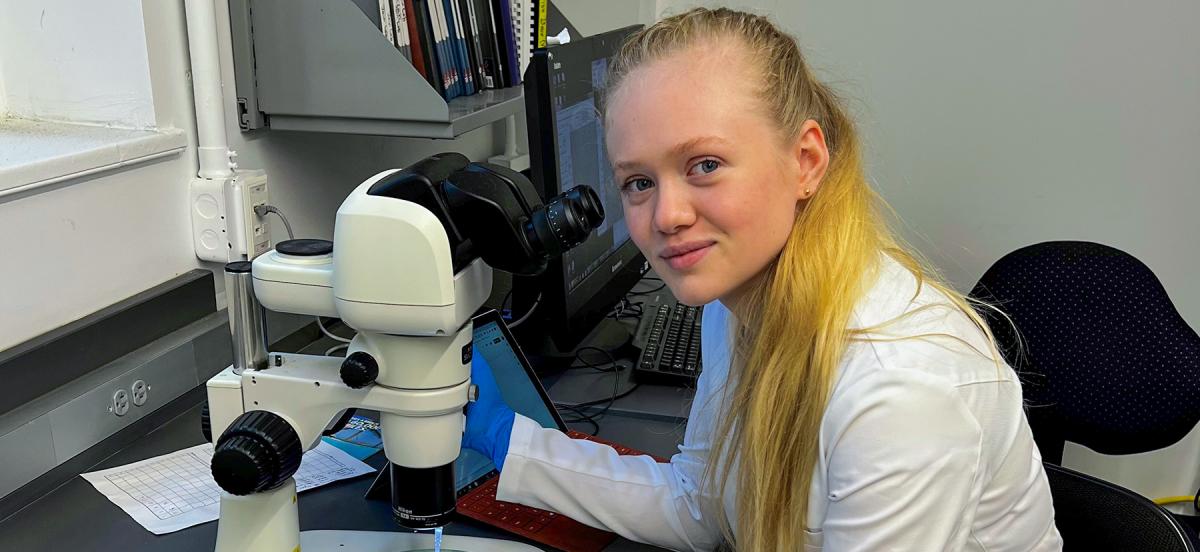Summer Centered: Rebecca Osbaldeston ‘24 Connects Serotonin and Decision Making

Rebecca Osbaldeston '24 is researching the role of serotonin in decision making in zebrafish this summer.
Details
The biology major is studying serotonin receptors in zebrafish, and their connection with decision making, with the support of the Velay Fellowship.
Rebecca Osbaldeston ‘24 decided to spend her summer studying just that: deciding. Specifically, the biology major, who is minoring in health studies and is concentrating in biochemistry, is studying serotonergic pathways involved in decision making, in the lab of Roshan Jain, assistant professor of biology. Osbaldeston’s research position is funded by the Koshland Integrated Natural Science Center’s Velay Fellowship, which provides financial support to women in science research positions.
Using the gene-editing technology CRISPR, Osbaldeston, along with her fellow students in Jain’s lab, studies how reception of serotonin through 5-HT neural receptors affects acoustic behavior selection in zebrafish.
“Acoustic behavior selection is the process of an organism being exposed to a sound, and its neural circuitry deciding the appropriate behavioral response to the noise,” she explained. While loud sounds may always trigger the fight-or-flight response in zebrafish, she is particularly observing how gene editing affects their reaction to softer sounds.
“From this project, we hope to learn the specific functions of this complicated set of serotonin receptors,” she said. Osbaldeston is joined on the Jain lab team by John Dvorak ‘23, Isabel Ray ‘23, Matthew Curran ‘24, and Kevin Villafane ‘24. Together, they will further examine how neurological disorders, such as schizophrenia, anxiety, panic attacks, mood disorders, and sleep apnea, are linked to serotonin reception.
Osbaldeston’s daily responsibilities include conducting CRISPR gene-editing on zebrafish embryos to prevent the creation of specific serotonin receptors, exposing larvae to pharmacological agents, and running behavioral tests.
“Our behavioral tests involve putting fish in a 6 x 6 plate which we attach to a machine that delivers acoustic stimuli of set intensities, at regular intervals. The fish then respond to the sounds they are exposed to, and we computationally analyze their behavior to characterize them as fast escape behaviors, or slower, less intense responses,” Osbaldeston explained. She also assists her fellow lab members manage their zebrafish husbandry, as she has had prior experience in raising and working with them before.
Osbaldeston said that Jain’s unique mentorship style had drawn her to pursue this opportunity in his lab. She had previously worked with him and Shirley Lang on a research project adapting a zebrafish melanin qualification assay for glacier ice worms.
“I thought [Jain] was great at explaining difficult concepts and having me look at research from new perspectives,” she said. “I also appreciate that he has really high standards, because that helps me continue to find ways to improve. He’s also just very friendly and personable, so I have a lot of fun working with him. He has been an exceptional mentor throughout the research process.”
Zebrafish are considered one of the best model organisms to use in stem cell and regenerative medicine research, particularly because they are transparent and thus easy to observe as their organs develop. In the Jain lab, Osbaldeston is developing skills in CRISPR mutagenesis, data analysis, and scientific paper writing, all of which will be useful as she furthers her career.
“My future aspirations involve working toward an M.D.-Ph.D. to do research on stem cells and regenerative medicine, while practicing as a transplant surgeon,” she said. “What I’ve learned from this fellowship will be directly transferable to possible future work.”
“Summer Centered” is a series exploring our students’ campus-supported summer work.



